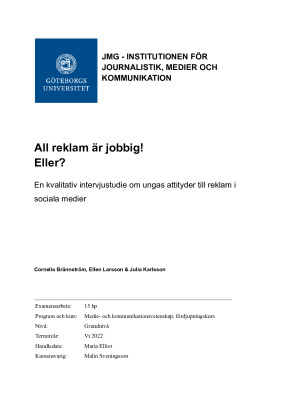All reklam är jobbig! Eller?
En kvalitativ intervjustudie om ungas attityder till reklam i
sociala medier
Executive summary
We live in a society that is embossed by social media. It has gone from being a platform where you share photos and updates with your closest friends, to becoming a platform that influencers make a financial living on. Today it is almost impossible not to be exposed to advertisements on social media, whether it is ads or influencer marketing. Today’s children and adolescents have never lived in a world without Smartphones, apps and likes and
therefore know nothing else.
The purpose of this essay is to investigate 13 to 16-year-olds’ attitudes towards advertising on social media. We have two questions that intend to answer the purpose of this essay. The first
question addresses what the respondents think advertising is on social media. The second question addresses which advertising generates the different attitudes in Ducoffe´s theoretical framework, Model of Attitude, according to the respondents. To analyze the respondents’ answers we applied the Model of Attitude, which has the intent to explain attitudes towards advertising on the Internet. The model also has the intent to show how different types of advertising create different types of values for the user that could result in different types of attitudes later on. To answer our thesis, we have applied a qualitative method to gain a deeper
understanding of adolescents’ attitudes towards advertising on social media. This is carried out with semi-structured interviews.
Based on the results from question one, it can be seen that the respondents consider both influencer marketing and paid ads to be advertising, which indicates an awareness of what advertising is. The majority of respondents were more positive about tips than advertising. The respondents tend to assimilate advertising that is characterized by parasocial relationships the most, which may be because it is perceived as a tip from a friend rather than advertising per se. You can also see that the respondents have a good understanding of how influencer marketing works and have a positive attitude towards it, if it is done in an honest way and with a genuine approach. However, few respondents knew about targeted advertising. When we informed them about what it meant, several respondents were positive about a social media page tailor-made towards them. A few on the other hand found it unpleasant, but in the end most still preferred an individualized page.
Based on the results from our second issue, it can be seen that the respondents’ answers about annoying, entertaining, and credible advertising correspond to the definition outlined in the Model of Attitude. However, Ducoffe’s description of information did not agree with the respondents’ perceptions. He believes that informative advertising is something positive, but the respondent’s answers indicated that it would rather be negative as they did not have the interest nor the will to read too much information.
To conclude this, we can see that the respondents generally have a positive attitude towards advertising on social media.

